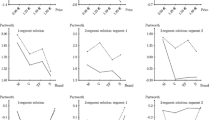Abstract
Mixed logit models represent a powerful discrete choice analytical model but require assumptions about the functional form of the parameter distributions. The use of unbounded distributions, such as the normal distribution, may be regarded as unsuitable where theory indicates that all are negatively affected by increases in an attribute, such as price. Bounded distributions such as the triangular and log-normal are unable to model the case where a section of the population is indifferent towards an attribute, while the remainder are negatively disposed toward it. Train and Sonnier’s bounded mixed logit model accommodates these features and is employed in this paper. A censored normal and Johnson’s S b distribution are used to model preferences in the UK for food attributes, including price and GM technology. Bi-modal distributions are identified regarding GM food: some are unlikely to ever consume it, some are close to indifference and willing to consume at relatively small discounts while the remainder are fairly unresponsive to further price reductions.
Similar content being viewed by others
References
BBC (1999), Blair backs modified food. BBC News, Monday 15 February, 1999.
C. Bhat (1998) ArticleTitle‘Accommodating Variations in Responsiveness to Level-of Service Variables in Travel Mode Choice Models’ Transportation Research A 32 455–507
C. Bhat (2000) ArticleTitle‘Incorporating Observed and Unobserved Heterogeneity in Urban Work Mode Choice Modeling’ Transportation Science 34 228–238 Occurrence Handle10.1287/trsc.34.2.228.12306
P. Boxall W. Adamowicz (2002) ArticleTitle‘Understanding Heterogeneous Preferences in Random Utility Models: A Latent Class Approach’ Environmental and Resource Economics 23 IssueID4 421–446 Occurrence Handle10.1023/A:1021351721619
M. Burton D. Rigby T. Young S. James (2001) ArticleTitle‘Choice Modeling Consumer Attitudes to GMOs in Food’ European Review of Agricultural Economics 28 IssueID4 479–498
Consumers Association (2002), ‘GM Dilemmas – Consumers and Genetically Modified Foods’, Policy Report, London.
J. R. DeShazo G. Fermo (2002) ArticleTitle‘Designing Choice Sets for Stated Preference Methods: The Effects of Complexity on Choice Consistency’ Journal of Environmental Economics and Management 44 123–143 Occurrence Handle10.1006/jeem.2001.1199
Eurobarometer (2001), ‘Europeans, Science and Technology’, Eurobarometer 55.2, European Commission, Brussels.
D. A. Hensher W. H. Greene (2003) ArticleTitle‘The Mixed Logit Model: The State of Practice’ Transportation 30 IssueID2 133–176 Occurrence Handle10.1023/A:1022558715350
Herriges, J. and C. Kling, eds. (1999), Valuing Recreation and the Environment: Revealed Preference Methods in Theory and Practice, New Horizons in Environmental Economics, Edward Elgar.
Independent on Sunday (2002), Sunday, 27 February 2002.
Johnson, R. M. (2000), ‘Monotonicity Constraints in Choice-based Conjoint with Hierarchical Bayes’, Research paper, Sawtooth Software.
B. Kristrom (1997) ArticleTitle‘Spike Models in Contingent Valuation’ American Journal Of Agricultural Economics 79 IssueID3 1013–1023
Marris, C., B. Wynne, P. Simmons and S. Weldon (2001), ‘Public Perceptions of Agricultural Biotechnologies in Europe’, Final Report of the PABE project, Lancaster University, UK.
D. McFadden K. Train (2000) ArticleTitle‘Mixed MNL Models of Discrete Response’ Journal of Applied Econometrics 15 447–470 Occurrence Handle10.1002/1099-1255(200009/10)15:5<447::AID-JAE570>3.0.CO;2-1
D. Revelt K. Train (1998) ArticleTitle‘Mixed Logit with Repeated Choices’ Review of Economics and Statistics 80 647–657 Occurrence Handle10.1162/003465398557735
D. Revelt K. Train (2000) ‘Specific Taste Parameters and Mixed Logit’ Department of Economics, University of California Berkeley
P. Ruud (1996) ‘Simulation of the Multinomial Probit Model: An Analysis of Covariance Matrix Estimation’ Department of Economics, University of California Berkeley
R. Scarpa P. Kristjanson A. Drucker M. Radeny E. S. K. Ruto J. E. O. Rege (2003) ArticleTitle‘Valuing Indigenous Cattle Breeds in Kenya: An Empirical Comparison of Stated and Revealed Preference Value Estimates’ Ecological Economics 45 IssueID3 409–426
J. Swait J. Louviere (1993) ArticleTitle‘The Role of the Scale Parameter in the Estimation and the Use of Multinomial Logit Models’ Journal of Marketing Research 30 305–314
T. Train (1998) ArticleTitle‘Recreation Demand Models with Taste Differences Over People’ Land Economics 74 IssueID2 230–239
Train, K. and G. Sonnier (2003), ‘Mixed Logit with Bounded Distributions of Partworths’, Working paper, University of California, Department of Economics.
K. Train (2001) ‘A Comparison of Hierarchical Bayes and Maximum Simulated Likelihood for Mixed Logit’ Department of Economics, University of California Berkeley
K. Train (2003) Discrete Choice Methods with Simulation Cambridge University Press New York
Author information
Authors and Affiliations
Corresponding author
Rights and permissions
About this article
Cite this article
Rigby, D., Burton, M. Modeling Disinterest and Dislike: A Bounded Bayesian Mixed Logit Model of the UK Market for GM Food. Environ Resource Econ 33, 485–509 (2006). https://doi.org/10.1007/s10640-005-4995-9
Accepted:
Issue Date:
DOI: https://doi.org/10.1007/s10640-005-4995-9




